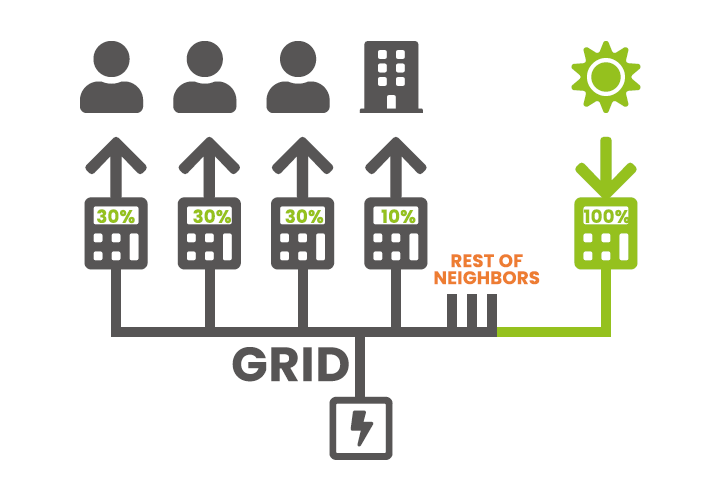Collective self-consumption in Spain. Explanation and practical example
From our point of view, collective self-consumption is the key to achieving the energy transition towards a sustainable city model. Since it allows multiple users such as a community of neighbours in a building, to take advantage of the same installation. According to article 17 of Law 49/1960 on horizontal property, it is only necessary that a third of the residents vote in favour for the project to go ahead.
The main objective is to establish a coefficient distribution for each consumer. The total sum of these coefficients must equal 100%, which means that all the energy produced by the collective self-consumption installation is distributed. A meter that measures the energy generated is placed in the photovoltaic system, at the end of the month the total amount produced is distributed among the participants in correspondence with their respective coefficients. This distribution is analysed hourly, that means the distribution is analysed each hour of each day of the month.
Example
Three residents in Cartagena have a collective self-consumption facility connected to the interior grid of the building. The plant has a nominal 6 kW power, generating 5 kWh of energy at 12 AM on a sunny day in March. Installation’s meter measures the energy produced and passes it to the General Power Line (LGA), which belongs to the community. The neighbours have decided to establish the distribution coefficients as follows:
- Gonzalo: β (partition coefficient) = 0.3
- Miguel: β = 0.3
- Alex: β = 0.3
- Common areas: β = 0.1

Let’s analyse the consumption of each neighbour at that time:
- Gonzalo: he is preparing lunch in the oven, while frying some onions on the hob. 2.2 kWh power consumption at 12 AM
- Miguel: he is playing a video game on the computer. Power consumption at 12 AM of 1.5 kWh
- Alex: he is out at work, however he has the fridge, freezer and house alarm connected. Energy consumption at 12 AM of 0.4 kWh
- Common areas: In the building there are neighbours coming and going, turning on the stair lights and using the elevator. Power consumption at 12 AM of 0.7 kWh
Next, we are going to analyse the energy they would have to pay, given that they are taking advantage of the energy produced by their collective self-consumption facility.
Energy to be billed = (Energy consumed) – (Energy produced by the installation) * β
- Gonzalo: 2.2 kWh – (5 kWh) * 0.3 = 0.7 kWh
- Miguel: 1.5 kWh – (5 kWh) * 0.3 = 0 kWh
- Alex: 0.4 kWh – (5 kWh) * 0.3 = – 1.1 kWh → as the value is negative, it means that he has energy left over from the self-consumption installation. This energy will be financially compensated at the price Alex agrees with his electricity provider.
- Common areas: 0.7 kWh – (5 kWh) * 0.1 = 0.2 kWh
These values that the distributor collects – since it is the owner of the meters – send them to the electricity providers of each client so that they can invoiced.
As you can see, it is a set of counters and numbers that are measured by distributors and providers. Simple operations made possible by the new smart remote management meters, which is why they were not reliable a few years ago.
It should be noted that the electricity produced by the installation is injected, as we have mentioned, into the General Power Line. This electricity is mixed with that of which is supplied and is distributed among all the residents of the building, even if the only ones who see it reflected in their bills are the neighbours who participate in the collective self-consumption system. This is because electricity cannot be directed and is displaced by the laws of physics. Still, it is 100% authentic renewable electricity, which «cleans» the electricity used from conventional sources (coal, cogeneration, nuclear …).
Our company are specialist in these types of installation, having carried out the first community installation in the city of Cartagena in February of this year. If you are interested in our services, do not hesitate to contact us for more information!
More information on Crusol at:



